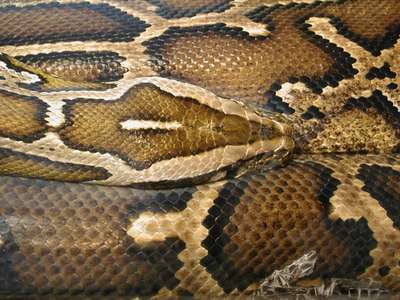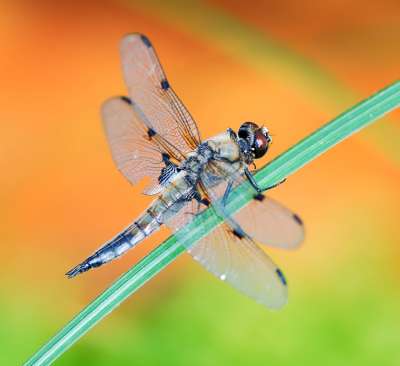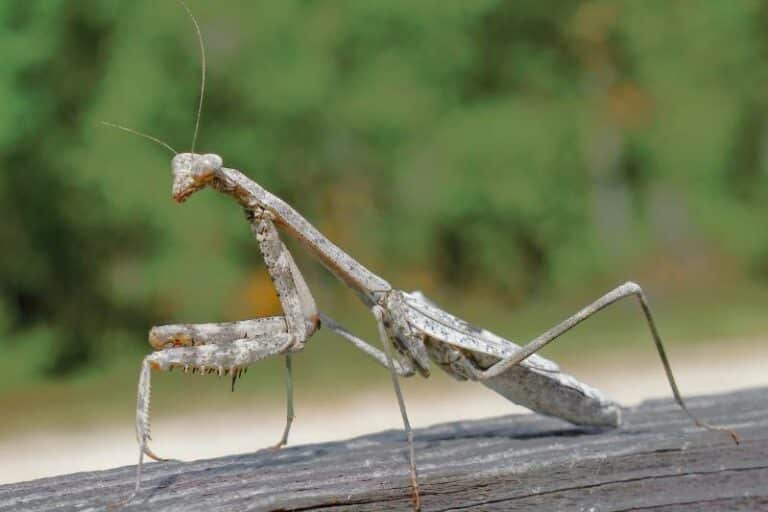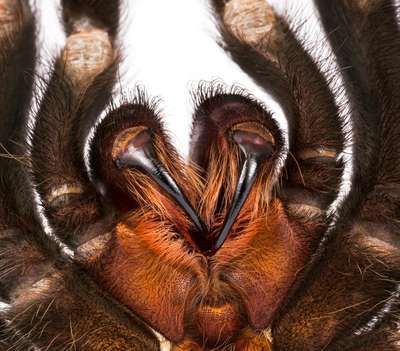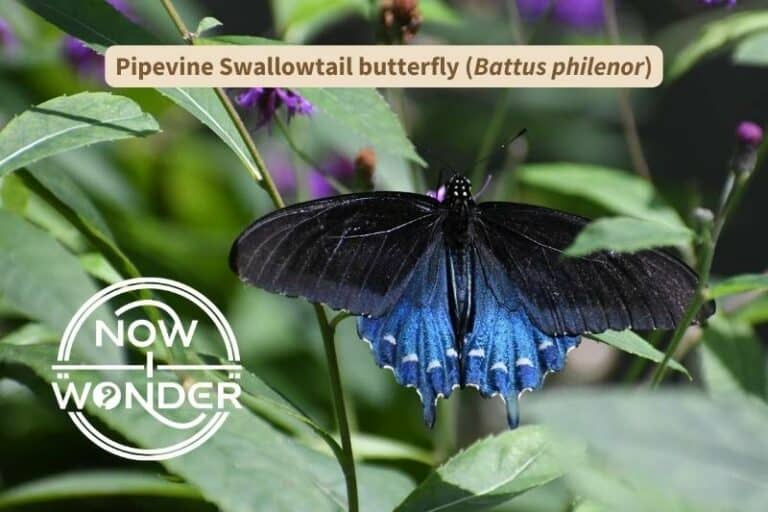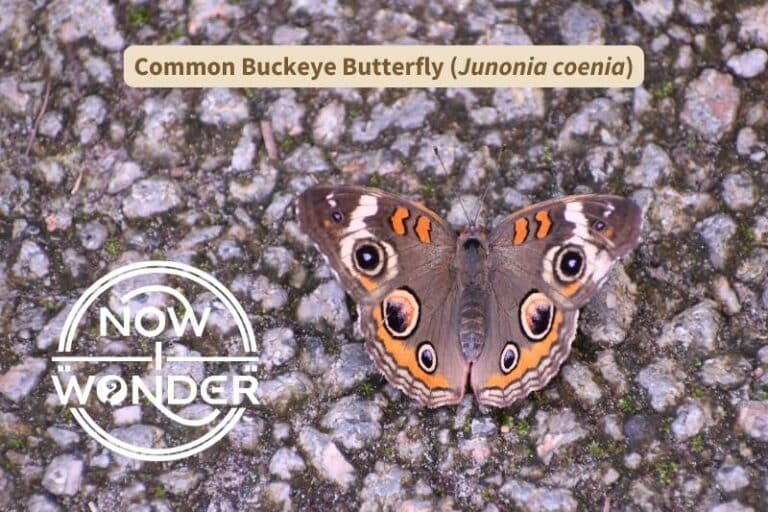Alligators and crocodiles have inhabited the waters of the world for millions of years. They spend some of their time on land but most of their time underwater, so it’s natural to wonder how they breathe and if they can breathe underwater.
Alligators cannot breathe underwater; they are reptiles and all reptiles breathe air through lungs. But alligators are able to remain submerged for long periods of time without breathing thanks to complex adaptations in their lungs and hearts that maximize use of stored oxygen.
Alligators and crocodiles belong to the Crocodylia order, which is the oldest reptile order on Earth. But being the oldest line of reptile doesn’t mean they are primitive creatures. On the contrary, crocodilians have some of the most complex hearts and lungs of all the reptiles – perhaps a consequence of their evolutionary history of evolving from aquatic to terrestrial then returning to a largely aquatic existence.
Read on for details of some of these remarkable adaptations and how they help alligators live their lives.
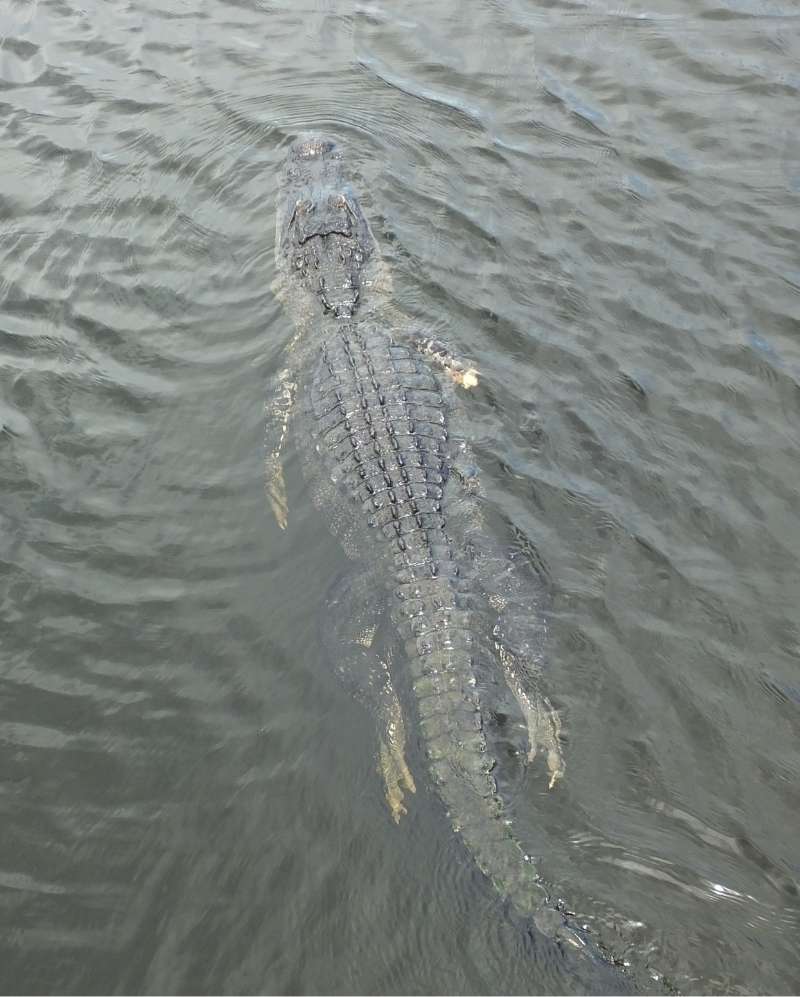
Functioning in water offers many advantages to semi-aquatic animals like alligators, such as concealment and a thermally stable environment. But living in water also offers challenges, especially to air-breathing animals like reptiles. The biggest challenge is how to keep themselves from drowning.
Alligators are natural swimmers and have superb control over their buoyancy in water; for details, check out this Now I Wonder post “How well do alligators swim?”. Their entire hunting strategy relies on ambushing prey from the water and breathing air is no problem when they float close enough to the surface that their nostrils are in the air.
But breathing air limits how long they can stay concealed underwater. An ambush predator who is constantly surfacing to breathe will give its position away so alligators have evolved the ability to stay submerged for long periods. How do they do it?
Energy demands
The currency of life is metabolic energy and being in water can demand a lot of it from air breathing animals. The first mechanism by which alligators and crocodiles can stay submerged for long periods of time without breathing is through lessening their need for the energy that breathing provides.
During aerobic metabolism, energy is created from oxygen; alligators obtain their oxygen through breathing air into their lungs. Oxygen diffuses across the surface of the lung tissue and attaches to hemoglobin molecules carried by red blood cells.
While oxygen is present in both air and water, the lungs of an air-breathing animal can’t function underwater; gases can’t be exchanged and the animal drowns unless it surfaces in time to take its next breath. The more active the animal, the more oxygen it uses, and the more often it needs to breathe to supply the oxygen demand.
Alligators are ectothermic animals, which means that their body temperatures and metabolic rates adjust to match their environment; their resting metabolic rates are about one-fifth or less that of humans (Grigg and Kirshner 2015).
Alligators and crocodiles, like most reptiles, live in warm areas where the water is often colder than air because of its high thermal inertia (water does not gain or lose heat as easily as air does). An alligator’s already comparatively low metabolic rate will slow further during prolonged dives.
The slower the metabolic rate, the longer any oxygen still circulating through the alligator’s body lasts so alligators and crocodiles are well-positioned to remain underwater for long periods of time without breathing, especially if they rest quietly.
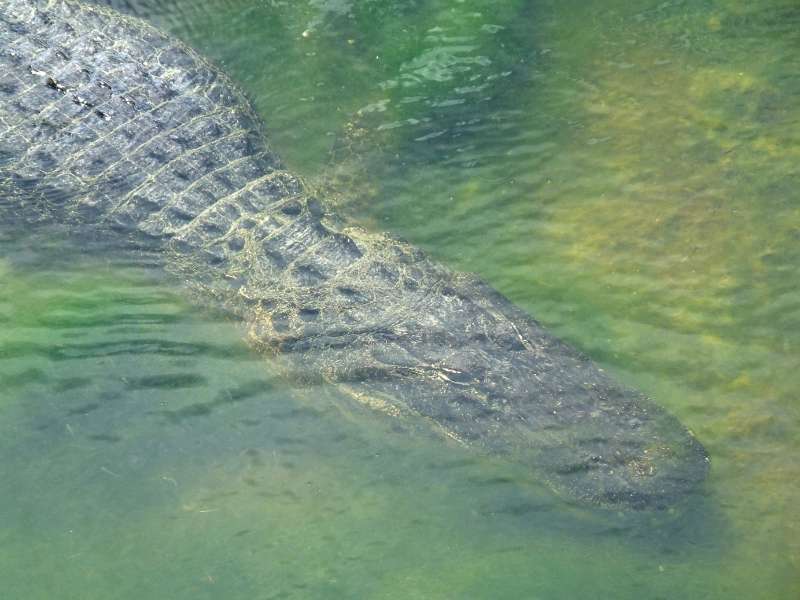
Lung adaptations
Alligators dive and remain underwater for two main reasons: foraging and resting. Foraging dives tend last only for a few minutes and don’t demand many physical or metabolic adjustments. The alligator either finds prey quickly or it doesn’t but either way, it simply returns to the surface to breathe.
But while alligators and crocodiles are today some of the biggest, baddest, most dangerous large predators on Earth today, they evolved during a time when even bigger predators roamed the Earth and they were prey.
Ancient alligators and crocodiles took refuge from predators in water; it was more dangerous for them to rest out in the open. Hiding underwater for long periods of time kept them safe from those ancestral, land-based predators, and this behavior persists today.
In fact, one of the longest dives ever recorded was performed by a 92.4lb (42kg) freshwater crocodile (Crocodylus johnstoni) who was responding to the perceived threat of people on the banks of its watering hole. This crocodile dove underwater and stayed there for 402 minutes – “one of the longest dive durations for any air-breathing vertebrate” (Campbell et al. 2010).
Modern alligators and crocodiles spend much of their time in “resting dives”. Resting dives are prolonged periods of submersion during which the animals remain motionless. Their control over their buoyancy is so refined that they expend almost no energy to keep themselves submerged, so their heart rate drops and oxygen demand plummets. This lets them extend the time between breaths significantly.
Alligator lungs are both similar and very different from mammal lungs, or even those of their cousin reptiles. The similarity is the exchange of oxygen and carbon dioxide across the cell membranes at the lung – capillary border. But alligators and crocodile lungs have two special adaptations that allow them to remain submerged without actually breathing for long periods of time: huge lung capacity and unidirectional air flow.
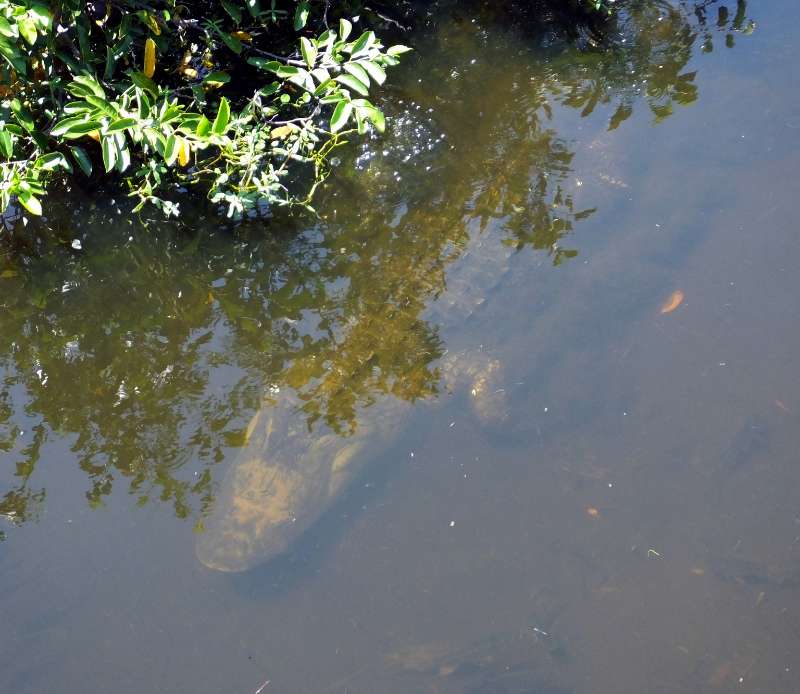
Lung capacity
Alligator lungs can hold a lot of air, which means they can submerge with a lot of oxygen on board. Alligators exercised on a treadmill took breaths that were four times deeper than their resting breaths and “relative to their weight, alligators take in more air per breath than has been reported for any other exercising animal” (Farmer and Carrier 2000).
An alligator’s lungs are separated from the rest of its internal organs by a sheet of connective tissue. Unlike the diaphragm of mammals, which is a domed muscles that powers inhalation and exhalation by contracting and relaxing, this connective tissue sheet does not directly make the alligator breathe.
Instead alligators have powerful muscles that attach to their pelvic bones which change the shape and volume of the abdominal cavity when they contract. The abdominal volume changes in two ways.
First, the contraction pulls the abdominal viscera back towards the tail and second, it tilts the pelvic bones. Both these movements gives the lungs more space and allows air to enter the trachea and bronchial passages. When these muscles relax, the liver and abdominal viscera shift forward and – along with some help from the muscles between the alligator’s ribs – push air out of the lungs.
Alligators and crocodiles can carefully and precisely regulate the amount of air in their lungs at any given time using these muscles. This control allows them to balance two potentially conflicting goals: to carry as much air as possible in their lungs when they submerge and to maintain the negative buoyancy needed to rest casually on the bottom without expending energy.
Unidirectional air flow
The second major adaptation that helps alligators remain submerged for long periods despite being unable to breathe underwater is the structure of their lungs themselves. Alligator and crocodile lungs move air in one direction only; it’s a one way system with the full volume of inspired air circulating through complex, gas-exchanging parabronchial tubes before being expelled.
This anatomy and unidirectional flow of air through the lung tissue is very different from mammalian lungs like ours, which always retain a significant volume of “dead air”. This dead air, called “residual volume, mixes with inspired air and thus decreases the efficiency of gas exchange into the blood; humans only extract about 25% of the available oxygen in each inhaled volume of air (Reece et al. 2012).
By moving the entire volume of air through the lungs and out on exhalation, alligators and crocodiles increase the efficiency of gas exchange and extract more oxygen from every breath. This oxygen diffuses into the pulmonary arteries on the pressure gradient set up between the interior of the lungs and the interior of the blood vessels.
Then the de-oxygenated air continues through the rest of the lungs in the same direction before ultimately getting exhaled. In this way, alligators constantly refresh the entire volume of air in the lungs – a helpful adaptation which provides maximum oxygen with minimal breaths.
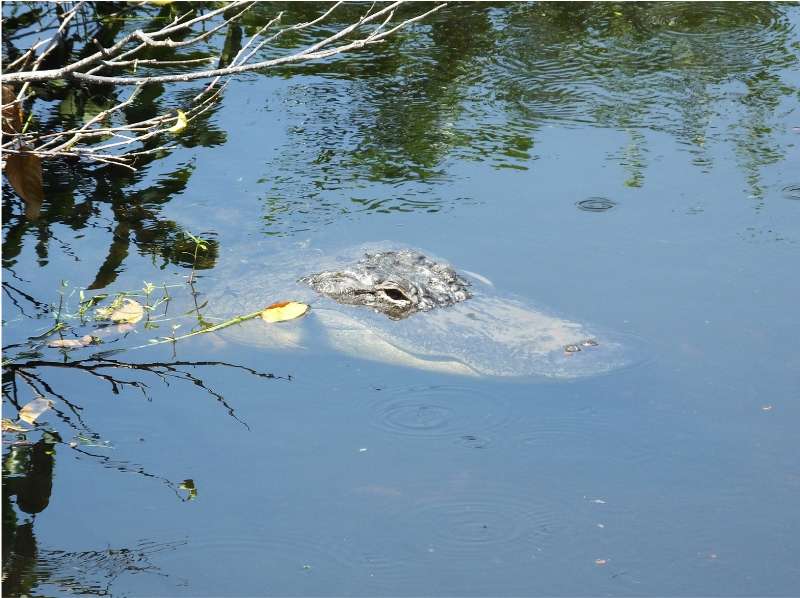
A specialized heart
Crocodilians like the American alligator have another important adaptation which allows them to remain underwater for long periods without breathing – a cardiopulmonary shunt.
When an alligator is on land or breathing normally, its four-chambered heart functions just like a mammal’s heart. The right ventricle pushes blood to the lungs through the pulmonary artery, the blood picks up oxygen, then returns to the left ventricle via the left atria, and is pushed out to the body.
The oxygenated (arterial) and de-oxygenated (venous) blood do not mix and the pressure is much higher in the left ventricle than the right (lung tissue is very delicate and can be damaged by blood pressures that are too high) (Grigg and Kirshner 2015).
Unlike a mammal’s heart, an alligator’s heart has a structure called the “Foramen of Panizza” that connects the right and left ventricles and is controlled by a muscular valve called the “cog-wheel valve”. This special structure is unique to crocodilians and sits at the top of the right ventricle, at the entrance to the pulmonary artery.
The “cogs” of this cog-wheel valve are shaped almost like human molar teeth. When the valve is open, the cogs are separated and blood flows freely along the pressure gradient. But during dives, the pressure in the right ventricle increases, the cog-wheel valve closes, and the teeth of the cogs mesh together to block off the pulmonary artery. This shunts blood away from the lungs and into the left ventricle, where is it then sent out to the body tissues.
Alligators and crocodiles may not be able to breathe underwater but this has not limited their success in the slightest. Instead, they evolved ingenious and advanced physiological workarounds that let them rest for hours on the bottom of ponds and swim with deadly intent beneath the surface – all while essentially holding their breath.
Related Now I Wonder Posts
To learn more about alligators, check out these other Now I Wonder posts:
If you’d like to learn more about reptilian hearts, check out this other Now I Wonder post “Do reptiles have hearts?“.
References
Campbell HA, Sullivan S, Read MA, Gordos MA, Franklin CE. 2010. Ecological and physiological determinants of dive durations in the freshwater crocodile. Functional Ecology: 24, 103-11. Available at: doi:10.1111/j.1365-2435.2009.01599.x
Farmer CG, Carrier DR. 2000. Ventilation and gas exchange during treadmill locomotion in the American alligator (Alligator mississippiensis). Journal of Experimental Biology. 203, no. 11: 1671-1678. Available at: https://doi.org/10.1242/jeb.203.11.1671
Grigg G, Kirshner D. 2015 Biology and evolution of crocodylians. Collingwood; CSIRO Publishing.
Reece JB, Taylor MR, Simon EJ, Dickey JL. 2012. Campbell biology: concepts and connections. 7th ed. San Francisco (CA): Pearson Education, Inc.

